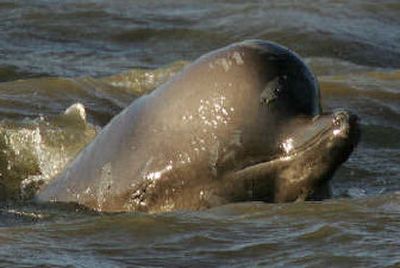Londoners flock to Thames for whale watching

LONDON – For a city that likes to think it has seen most everything, the spectacle Friday of a whale swimming past Parliament and the Millennium Eye and on up the Thames to the posh precincts around Chelsea, 40 miles from the nearest sea, just about took the pudding.
Thousands of people lined the riverbanks on a sunny day to catch a glimpse of the 15-foot-long bottlenose whale, as commentators on television debated whether it was old or young, how it had come to enter the Thames estuary, and its likely fate. Many feared that the 4-ton behemoth was ill, confused or weak and that it could be caught in the river’s powerful current, unable to find its way back to the sea.
At one stage, when the whale seemed to have stranded itself in the shallows near the Battersea Power Station, a man in street clothes walked into the river and shooed and splashed to coax it back to deeper water.
Although dolphins have been observed in the Thames, there was no record of a whale since the Museum of Natural History began compiling such statistics 113 years ago.
Helicopters hovered overhead and boats were used to try to turn the whale from continuing to swim upriver, where the water becomes progressively shallower and less salty.
Alan Knight, of the British Divers Marine Life Rescue group, said he feared the whale might be ill and had come to beach itself to die. Volunteers stood by to try to intervene if the whale stopped swimming freely.
If the whale is assessed as healthy, he said, the volunteers would try to keep it afloat with pontoons, place it in a launch and take it out to sea. But if they determine it is too sick to live, he told Britain’s Press Association, “We will euthanize it and consider it a success because it has not caused any more suffering.”
Northern bottle-nose whales normally live in the northern Atlantic Ocean near the edge of the continental shelves. They are deep-ocean whales that hunt squid and fish for food and are known for their ability to swim to great depths and stay submerged for as long as one hour.
The whale in the Thames, however, was staying near the surface and spouting water from its blowhole every few minutes.
As news of the whale’s presence spread, people left their homes and offices to come out and see it from embankments and bridges. Television news showed little else.
Peter Evans, of the Sea Watch Foundation, speculated the whale was sick or had been tempted up the river following a school of fish.